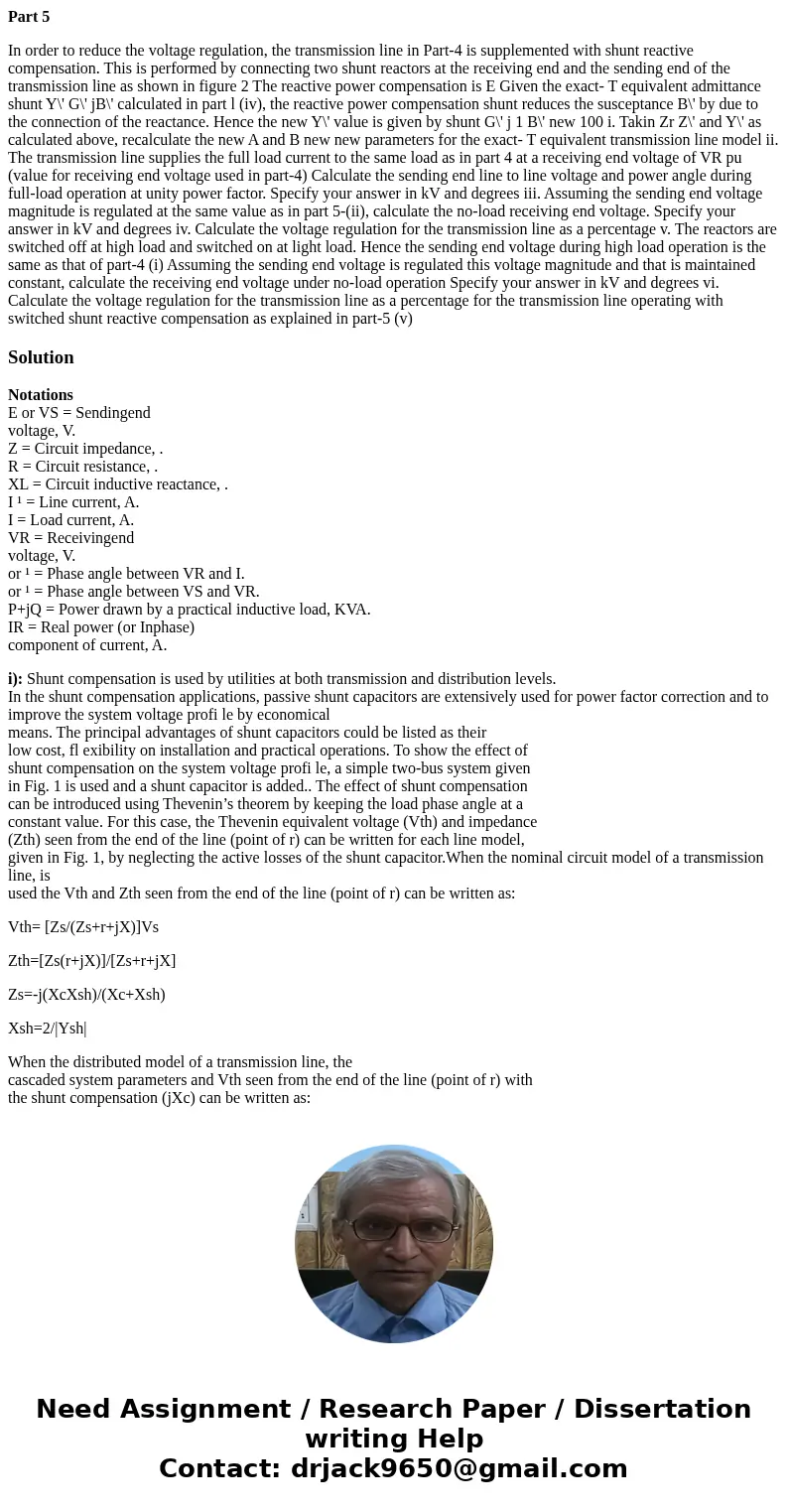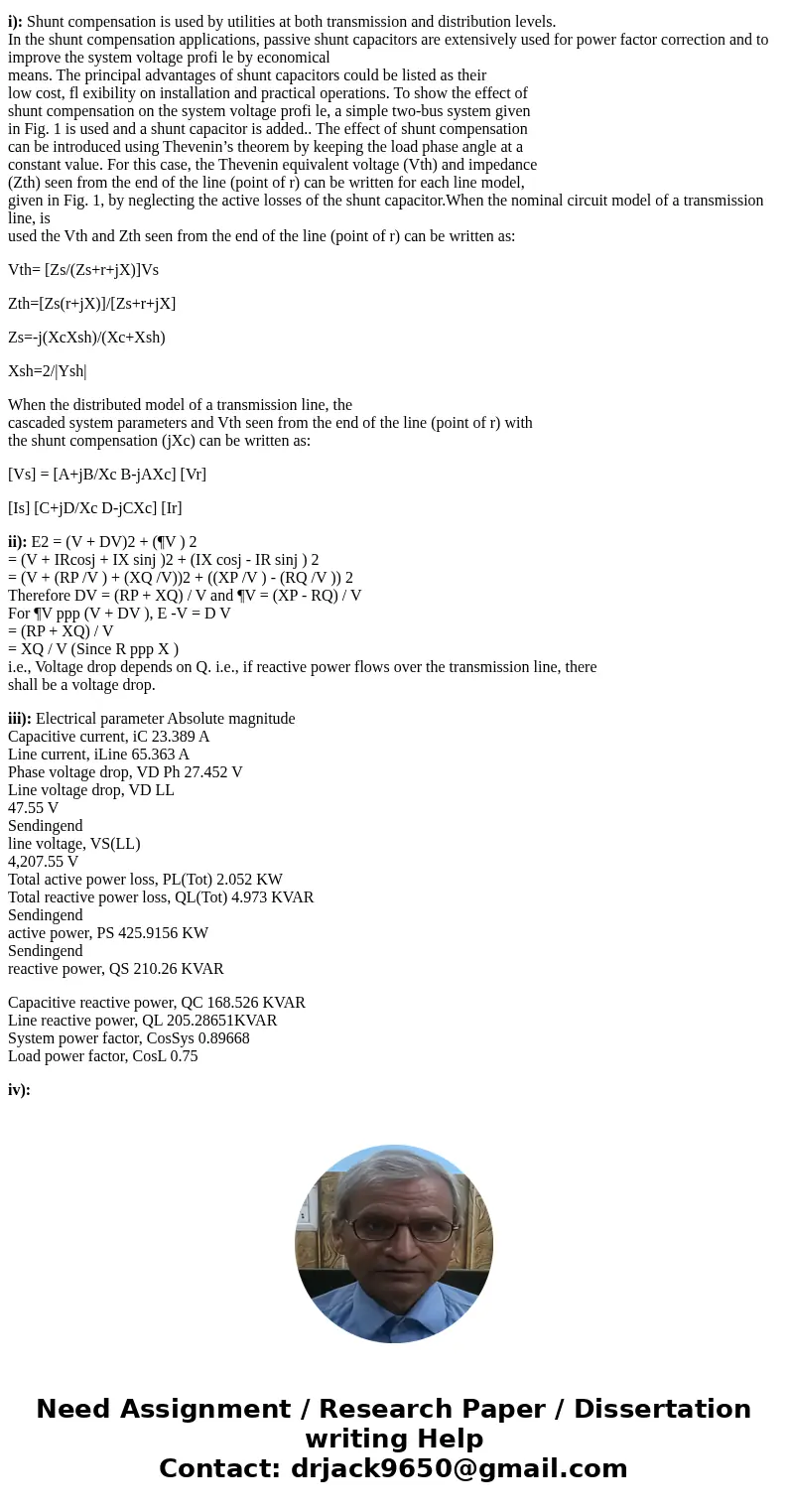Part 5 In order to reduce the voltage regulation the transmi
Part 5
In order to reduce the voltage regulation, the transmission line in Part-4 is supplemented with shunt reactive compensation. This is performed by connecting two shunt reactors at the receiving end and the sending end of the transmission line as shown in figure 2 The reactive power compensation is E Given the exact- T equivalent admittance shunt Y\' G\' jB\' calculated in part l (iv), the reactive power compensation shunt reduces the susceptance B\' by due to the connection of the reactance. Hence the new Y\' value is given by shunt G\' j 1 B\' new 100 i. Takin Zr Z\' and Y\' as calculated above, recalculate the new A and B new new parameters for the exact- T equivalent transmission line model ii. The transmission line supplies the full load current to the same load as in part 4 at a receiving end voltage of VR pu (value for receiving end voltage used in part-4) Calculate the sending end line to line voltage and power angle during full-load operation at unity power factor. Specify your answer in kV and degrees iii. Assuming the sending end voltage magnitude is regulated at the same value as in part 5-(ii), calculate the no-load receiving end voltage. Specify your answer in kV and degrees iv. Calculate the voltage regulation for the transmission line as a percentage v. The reactors are switched off at high load and switched on at light load. Hence the sending end voltage during high load operation is the same as that of part-4 (i) Assuming the sending end voltage is regulated this voltage magnitude and that is maintained constant, calculate the receiving end voltage under no-load operation Specify your answer in kV and degrees vi. Calculate the voltage regulation for the transmission line as a percentage for the transmission line operating with switched shunt reactive compensation as explained in part-5 (v)Solution
Notations
E or VS = Sendingend
voltage, V.
Z = Circuit impedance, .
R = Circuit resistance, .
XL = Circuit inductive reactance, .
I ¹ = Line current, A.
I = Load current, A.
VR = Receivingend
voltage, V.
or ¹ = Phase angle between VR and I.
or ¹ = Phase angle between VS and VR.
P+jQ = Power drawn by a practical inductive load, KVA.
IR = Real power (or Inphase)
component of current, A.
i): Shunt compensation is used by utilities at both transmission and distribution levels.
In the shunt compensation applications, passive shunt capacitors are extensively used for power factor correction and to improve the system voltage profi le by economical
means. The principal advantages of shunt capacitors could be listed as their
low cost, fl exibility on installation and practical operations. To show the effect of
shunt compensation on the system voltage profi le, a simple two-bus system given
in Fig. 1 is used and a shunt capacitor is added.. The effect of shunt compensation
can be introduced using Thevenin’s theorem by keeping the load phase angle at a
constant value. For this case, the Thevenin equivalent voltage (Vth) and impedance
(Zth) seen from the end of the line (point of r) can be written for each line model,
given in Fig. 1, by neglecting the active losses of the shunt capacitor.When the nominal circuit model of a transmission line, is
used the Vth and Zth seen from the end of the line (point of r) can be written as:
Vth= [Zs/(Zs+r+jX)]Vs
Zth=[Zs(r+jX)]/[Zs+r+jX]
Zs=-j(XcXsh)/(Xc+Xsh)
Xsh=2/|Ysh|
When the distributed model of a transmission line, the
cascaded system parameters and Vth seen from the end of the line (point of r) with
the shunt compensation (jXc) can be written as:
[Vs] = [A+jB/Xc B-jAXc] [Vr]
[Is] [C+jD/Xc D-jCXc] [Ir]
ii): E2 = (V + DV)2 + (¶V ) 2
= (V + IRcosj + IX sinj )2 + (IX cosj - IR sinj ) 2
= (V + (RP /V ) + (XQ /V))2 + ((XP /V ) - (RQ /V )) 2
Therefore DV = (RP + XQ) / V and ¶V = (XP - RQ) / V
For ¶V ppp (V + DV ), E -V = D V
= (RP + XQ) / V
= XQ / V (Since R ppp X )
i.e., Voltage drop depends on Q. i.e., if reactive power flows over the transmission line, there
shall be a voltage drop.
iii): Electrical parameter Absolute magnitude
Capacitive current, iC 23.389 A
Line current, iLine 65.363 A
Phase voltage drop, VD Ph 27.452 V
Line voltage drop, VD LL
47.55 V
Sendingend
line voltage, VS(LL)
4,207.55 V
Total active power loss, PL(Tot) 2.052 KW
Total reactive power loss, QL(Tot) 4.973 KVAR
Sendingend
active power, PS 425.9156 KW
Sendingend
reactive power, QS 210.26 KVAR
Capacitive reactive power, QC 168.526 KVAR
Line reactive power, QL 205.28651KVAR
System power factor, CosSys 0.89668
Load power factor, CosL 0.75
iv):


 Homework Sourse
Homework Sourse